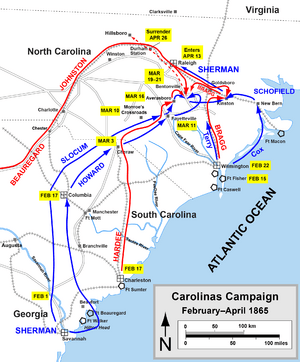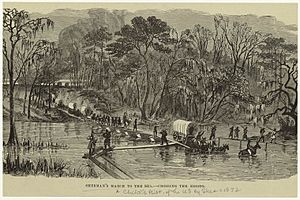Campaign of the Carolinas facts for kids
Quick facts for kids Campaign of the Carolinas |
|||||||||
|---|---|---|---|---|---|---|---|---|---|
| Part of the Western Theater of the American Civil War | |||||||||
 The Burning of Columbia, South Carolina, on February 17, 1865, as depicted in Harper's Weekly |
|||||||||
|
|||||||||
| Belligerents | |||||||||
| Commanders and leaders | |||||||||
| Units involved | |||||||||
| Army of Tennessee | |||||||||
The Campaign of the Carolinas was a major military operation during the American Civil War. It took place from January 1 to April 26, 1865. This campaign was the final big push by the United States Army (also known as the Union Army) against the Confederate States Army in the western part of the war.
Union General William Tecumseh Sherman led his troops north from Savannah, Georgia, through the states of North Carolina and South Carolina. His goal was to meet up with other Union forces in Virginia. The campaign ended when Confederate General Joseph E. Johnston's army was defeated at the Battle of Bentonville. Johnston then surrendered to Sherman on April 26, 1865. This surrender effectively brought the American Civil War to an end.
Contents
Why the Carolinas Campaign Happened
After General Sherman captured Savannah, Georgia, he had just finished his famous 'Sherman's March to the Sea'. His boss, Union General Ulysses S. Grant, wanted Sherman to send his army by ship to Virginia. Grant was stuck in a long fight called the Siege of Petersburg against Confederate General Robert E. Lee.
But Sherman had a different idea. He convinced Grant that he should march his army north through the Carolinas instead. Sherman wanted to destroy anything important for the Confederate war effort along the way. This would be similar to what he did in Georgia. Sherman especially wanted to target South Carolina. This was because South Carolina was the first state to leave the Union. He believed attacking it would really hurt the South's morale.
In late January 1865, Sherman's army started moving towards Columbia, South Carolina. He had about 60,000 soldiers. His army was split into two main groups. As he marched north, more soldiers joined him. By April 1, he commanded nearly 89,000 men.
On the Confederate side, General Joseph E. Johnston was in charge again. He had far fewer soldiers than Sherman. His army had been weakened by earlier battles. By mid-March, he had only about 9,500 men. Even with some reinforcements, his army was much smaller than Sherman's.
Sherman's plan was to avoid smaller Confederate groups in places like Augusta, Georgia, and Charleston, South Carolina. He aimed to reach Goldsboro, North Carolina, by mid-March. To confuse the Confederates, Sherman marched his armies in many different directions at once. This made it hard for the scattered Confederate defenders to guess where he was really going. His main target was the state capital of Columbia, South Carolina.
Key Battles of the Campaign
Here are some of the important battles that happened during the Carolinas Campaign:
Rivers' Bridge (February 3, 1865)
Confederate forces tried to stop Sherman's army from crossing the Salkehatchie River. But Union soldiers managed to cross the river and attack the Confederates from the side. The Confederates had to retreat. This only delayed the Union army for one day.
On February 17, Columbia, South Carolina, surrendered to Sherman's forces. Union soldiers found many supplies in the city. Fires started in the city, and strong winds quickly spread the flames. Much of the city center was destroyed. People still debate how the fires started. Some say they were accidental, others say Union soldiers started them on purpose. Some also claim that retreating Confederate soldiers set fire to cotton bales as they left. On the same day, Confederates also left Charleston, South Carolina. The next day, Sherman's forces destroyed military targets in Columbia, like railroad stations and weapons factories. On February 22, Wilmington, North Carolina, also surrendered.
Aiken (February 11)
This battle happened in South Carolina. Union General Hugh Judson Kilpatrick attacked the city of Aiken, South Carolina. Confederate General Joseph Wheeler led his cavalry and local defenders against Kilpatrick. Wheeler tried to trap the Union forces, but a Confederate soldier fired too early. This made Wheeler order a full attack. The battle involved close-up fighting. Kilpatrick's forces were defeated and had to retreat.
Wyse Fork (March 7–10)
Union General John Schofield planned to move inland from Wilmington, North Carolina. At the same time, Union General Jacob Dolson Cox led forces from New Bern, North Carolina, towards Goldsboro. On March 7, Cox's advance was stopped by Confederate forces near Kinston, North Carolina. The Confederates tried to attack the Union army's sides, but their attacks failed. On March 9, Union forces received more soldiers. They fought off new Confederate attacks on March 10. The Confederates then retreated, and Kinston fell to the Union on March 14.
Monroe's Cross Roads (March 10)
As Sherman's army moved into North Carolina, General Kilpatrick's cavalry protected its left side. On the night of March 9, two of Kilpatrick's groups camped near the Charles Monroe House. Early on March 10, Confederate cavalry surprised the Union soldiers in their camps. They drove them back and captured some wagons and cannons. But the Union soldiers regrouped and fought back. They got their cannons and camps back after a tough fight. With more Union soldiers arriving, the Confederates pulled back.
Averasborough (March 16)
On March 15, Kilpatrick's cavalry met Confederate forces led by General William J. Hardee. Hardee's troops were set up along the Raleigh Road. Kilpatrick pulled back and asked for more soldiers. During the night, Union infantry arrived. At dawn on March 16, the Union soldiers advanced. They pushed back the Confederate scouts but were stopped by the main Confederate line. The Confederates even counterattacked. Later that morning, the Union forces attacked again with many more soldiers. They pushed the Confederates back from two lines of defenses. But they were stopped at a third line. Hardee retreated during the night after holding up the Union advance for almost two days.
Bentonville (March 19–21)
While one part of Sherman's army was fighting at Averasborough, the other part marched towards Goldsboro. On March 19, Union General Henry Warner Slocum met Confederate General Joseph E. Johnston's army at Bentonville. Johnston had gathered more soldiers, bringing his total to about 21,000 men. Late in the afternoon, Johnston attacked, breaking through the Union line. Only strong counterattacks and desperate fighting stopped the Confederate attack. More Union soldiers joined the fight as they arrived. Five Confederate attacks failed to move the Union defenders, and darkness ended the first day of fighting.
On March 20, Slocum received many more soldiers, but the fighting was not constant. Sherman was ready to let Johnston retreat. However, on March 21, Johnston stayed in position to move his wounded soldiers. Small fights broke out along the entire front. In the afternoon, Union General Joseph A. Mower led his division behind Johnston's army. Confederate counterattacks stopped Mower's advance, saving their only way to communicate and retreat. Mower pulled back, ending the fighting for the day. During the night, Johnston retreated across a bridge at Bentonville. Union forces chased them at first light, pushing back the Confederate rear guard and saving the bridge. Sherman then regrouped at Goldsboro and chased Johnston towards Raleigh, North Carolina.
What Happened Next
Sherman's Carolinas Campaign was a tough march. His troops covered about 425 miles (684 km) in 50 days. It was similar to his march through Georgia, but even harder physically. However, the Confederate forces he faced were much smaller and less hopeful.
When General Joseph E. Johnston met with Confederate President Jefferson Davis in Greensboro, North Carolina, on April 12–13, he told the president:
Our people are tired of the war, feel themselves whipped, and will not fight. Our country is overrun, its military resources greatly diminished, while the enemy's military power and resources were never greater and may be increased to any extent desired. ... My small force is melting away like snow before the sun.
On April 18, just three days after the assassination of President Abraham Lincoln, Johnston signed a peace agreement with Sherman at Bennett Place. This was a farmhouse near Durham, North Carolina. Sherman faced some problems for offering surrender terms that included political issues, which he wasn't authorized to do. This confusion lasted until April 26. On that day, Johnston agreed to purely military terms and officially surrendered his army. This included all Confederate forces in the Carolinas, Georgia, and Florida.
This was the second major surrender that month. On April 9, General Robert E. Lee had surrendered his army at Appomattox Court House. Johnston's surrender was basically the end of the Confederacy. A few smaller Confederate forces continued to fight in other areas for a short time, but the main war was over.
Images for kids








